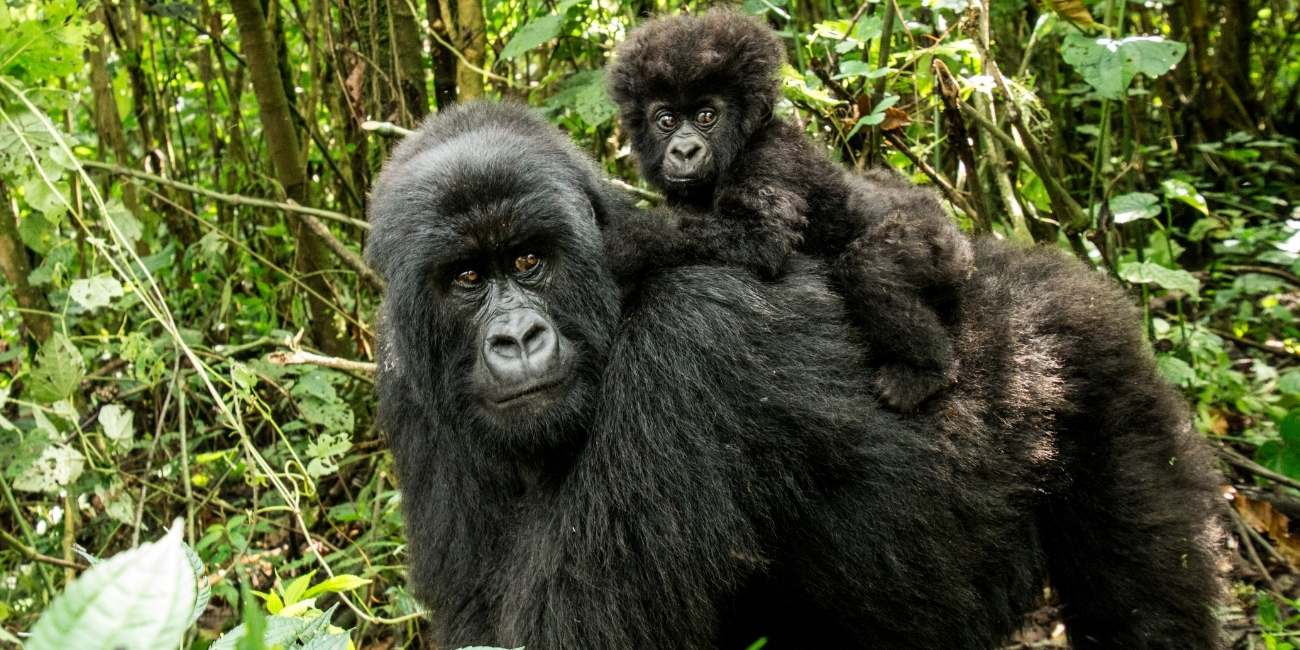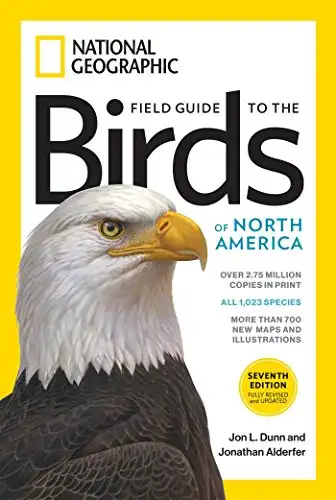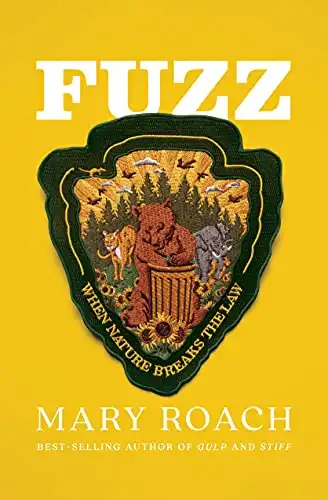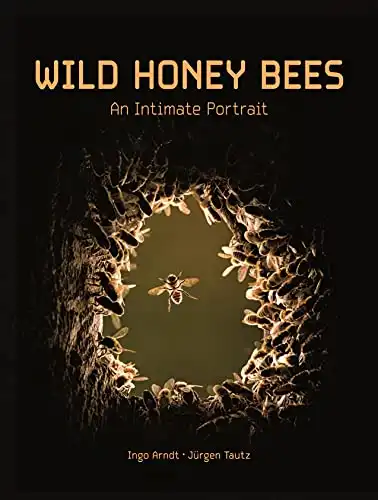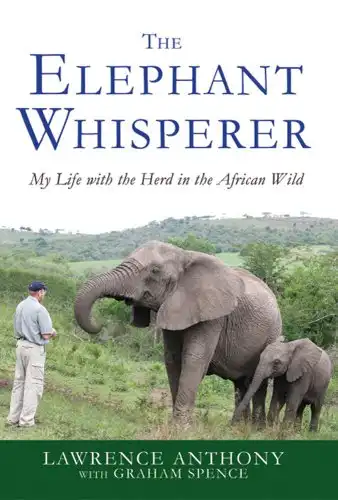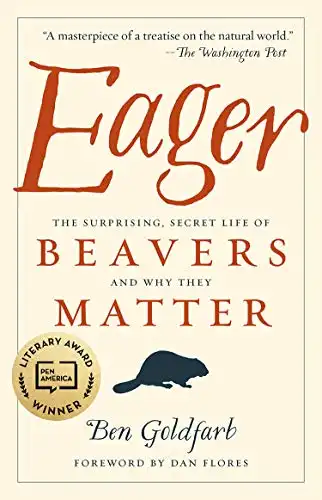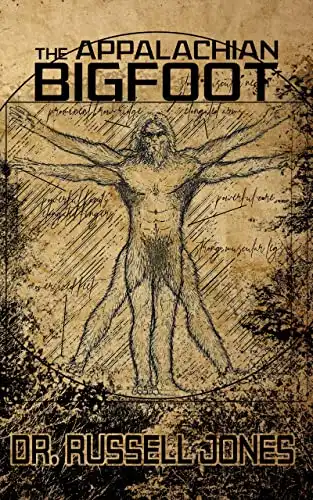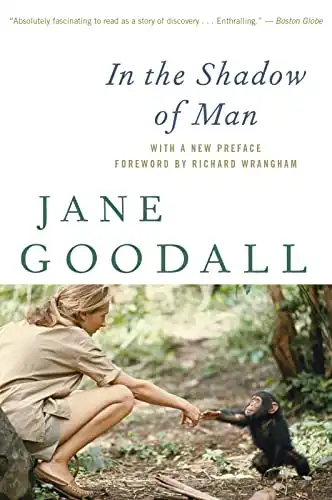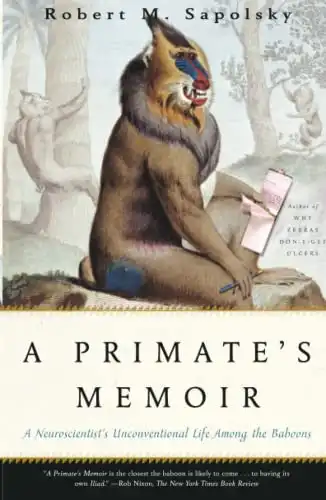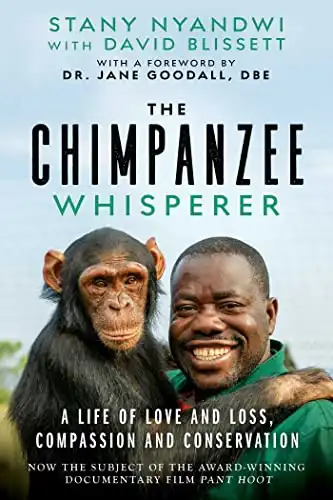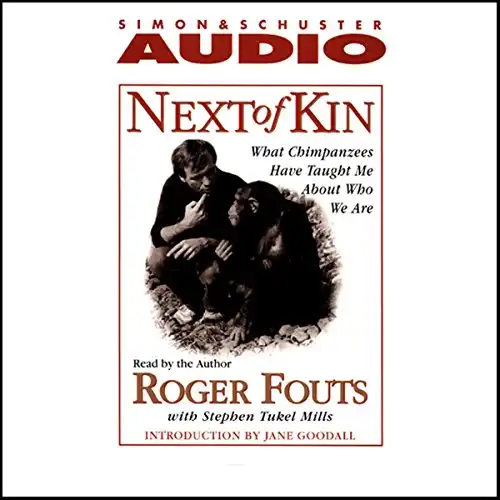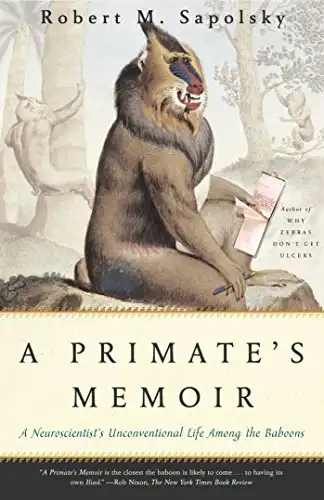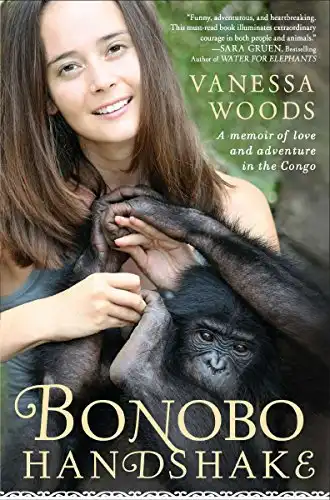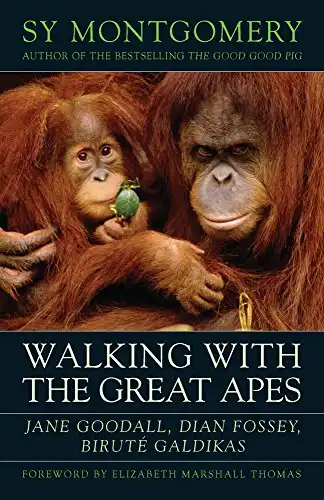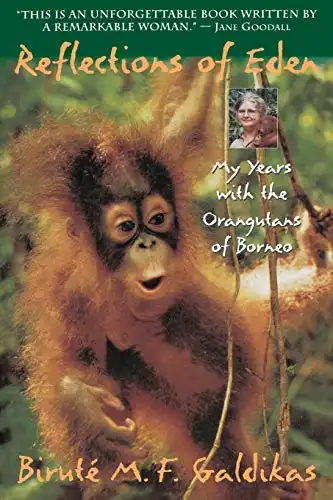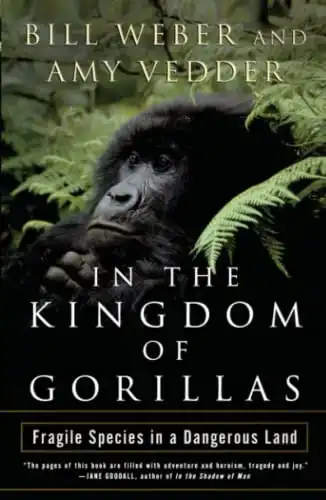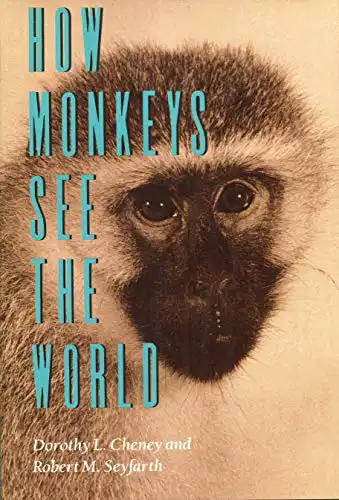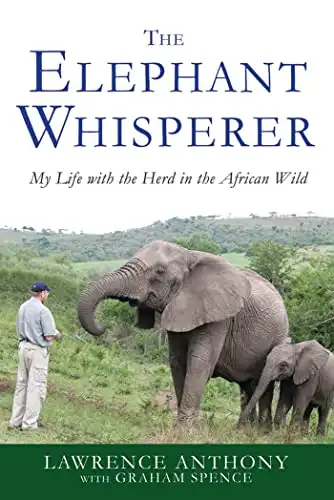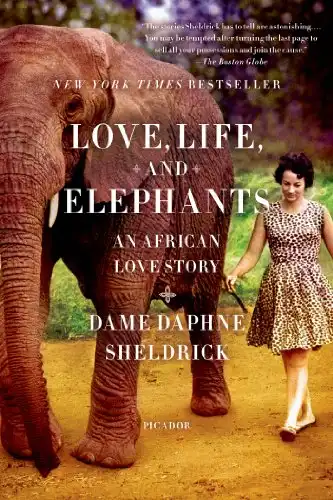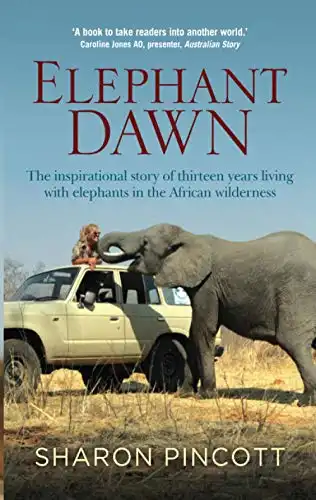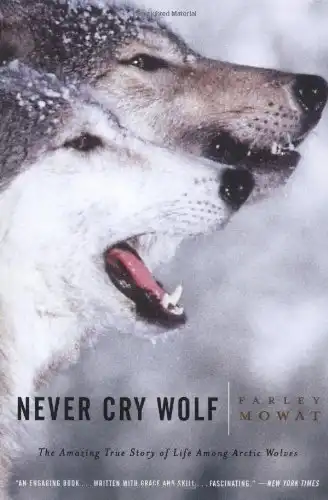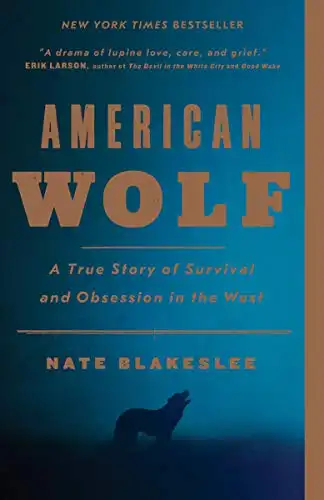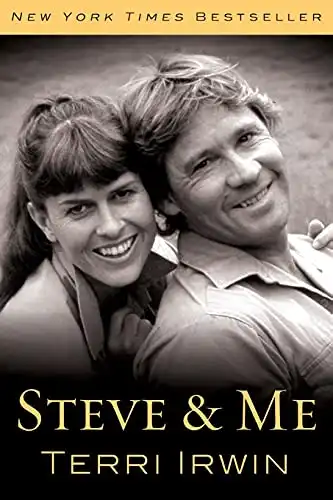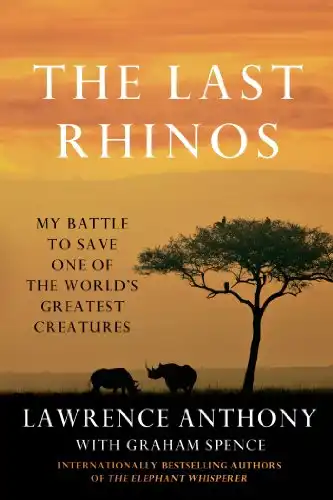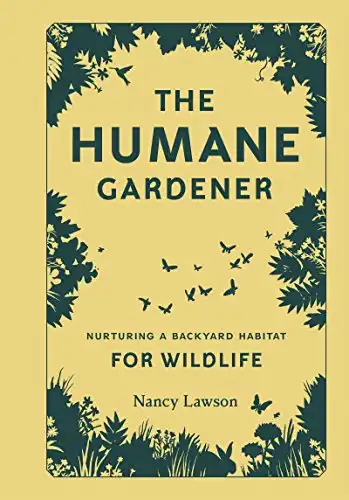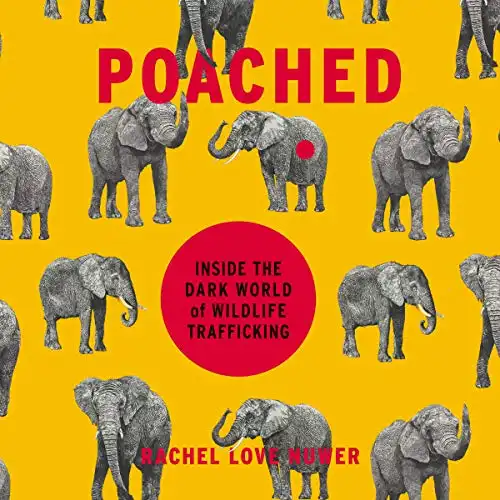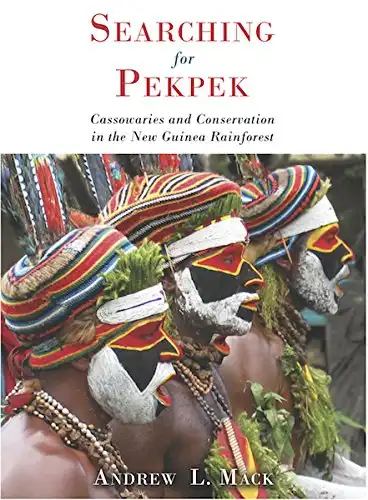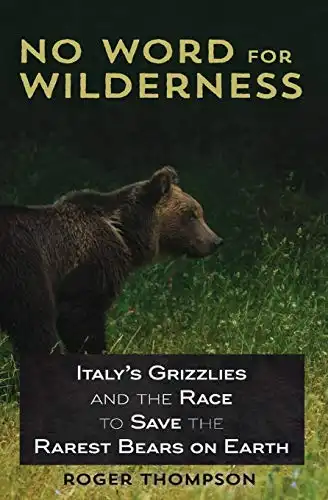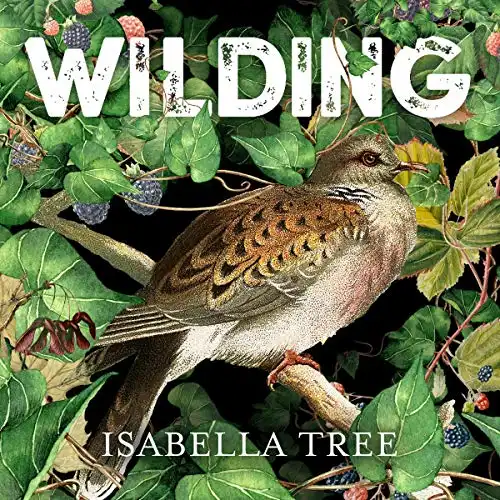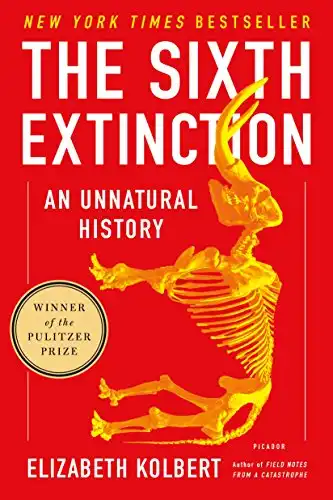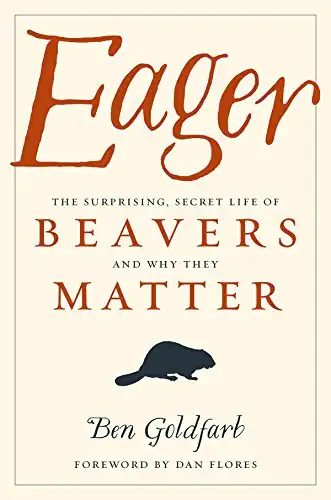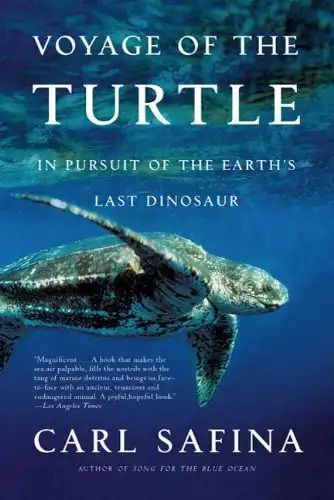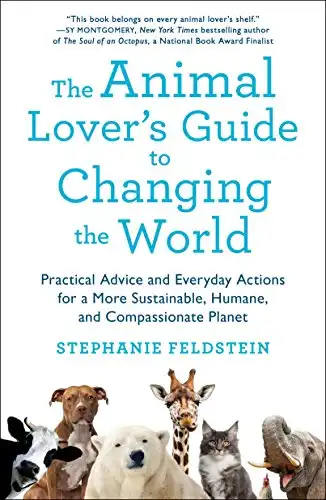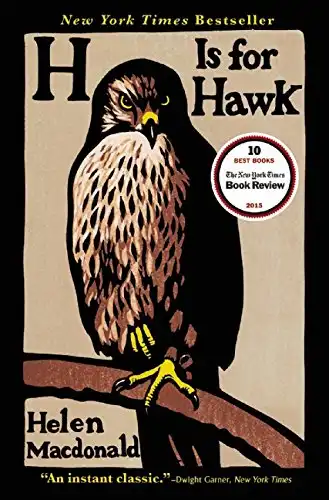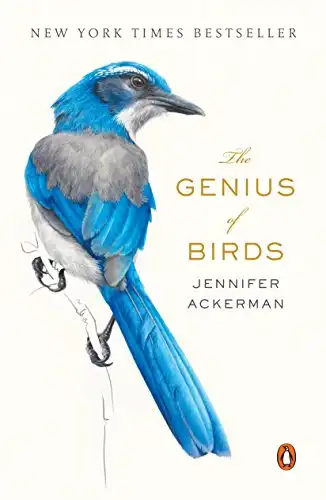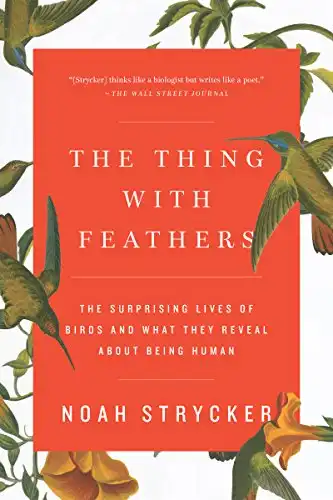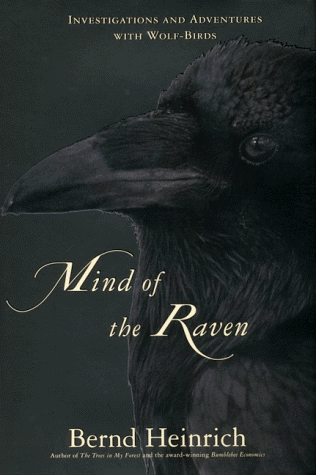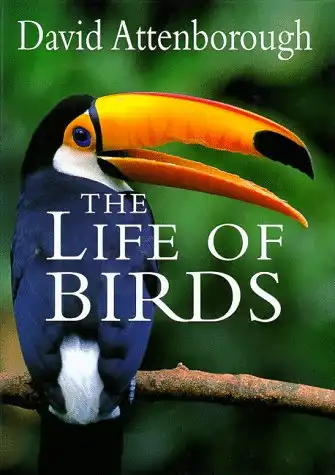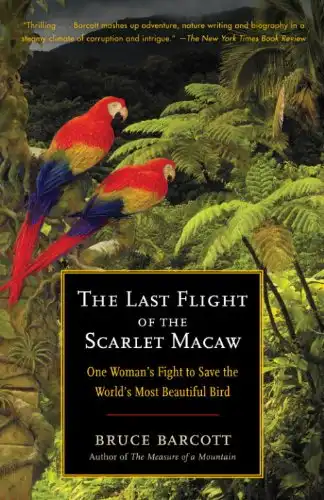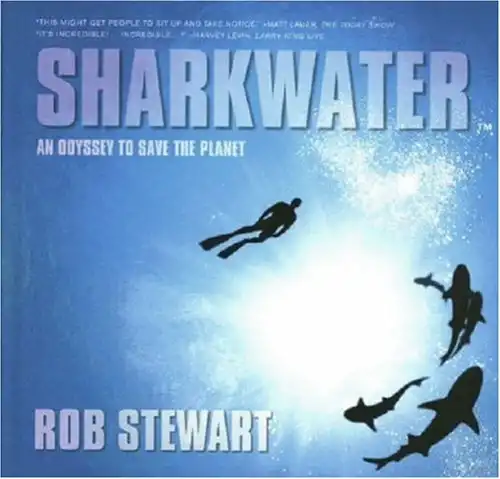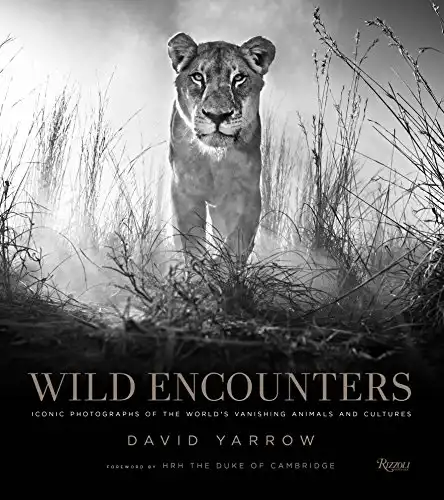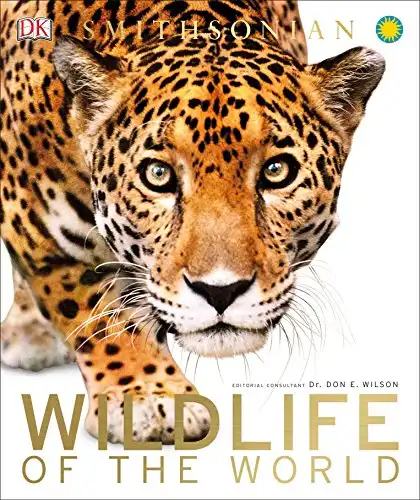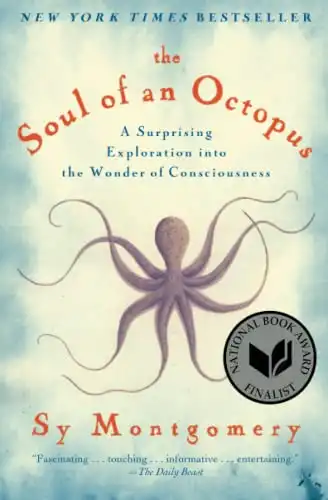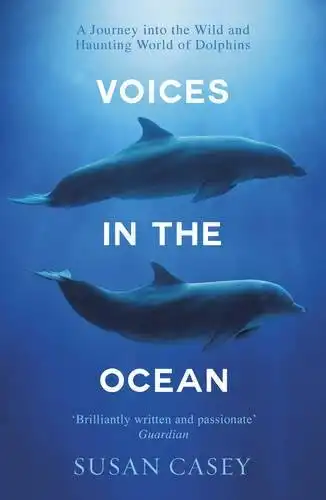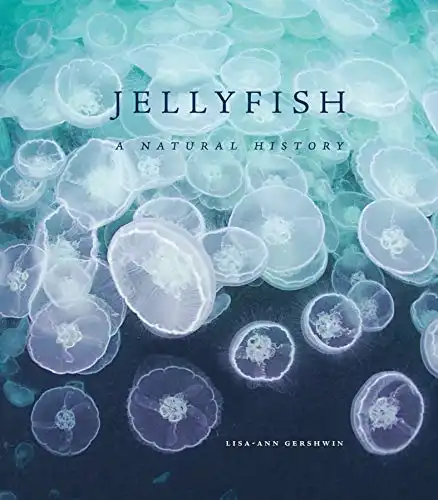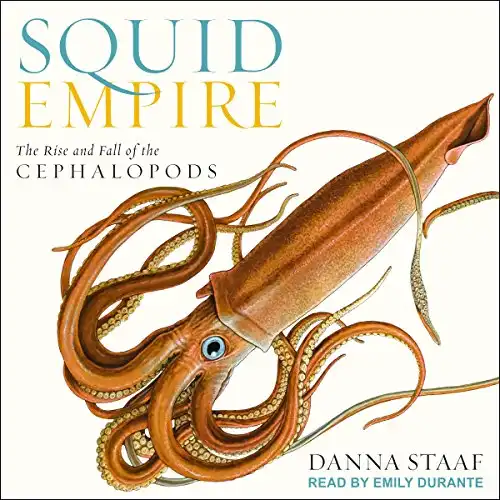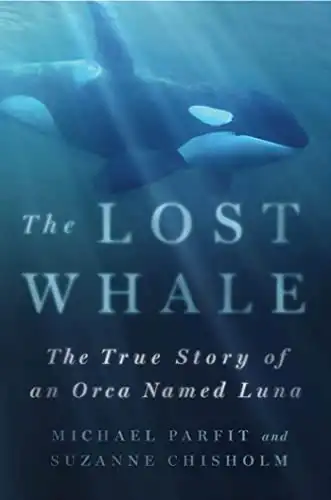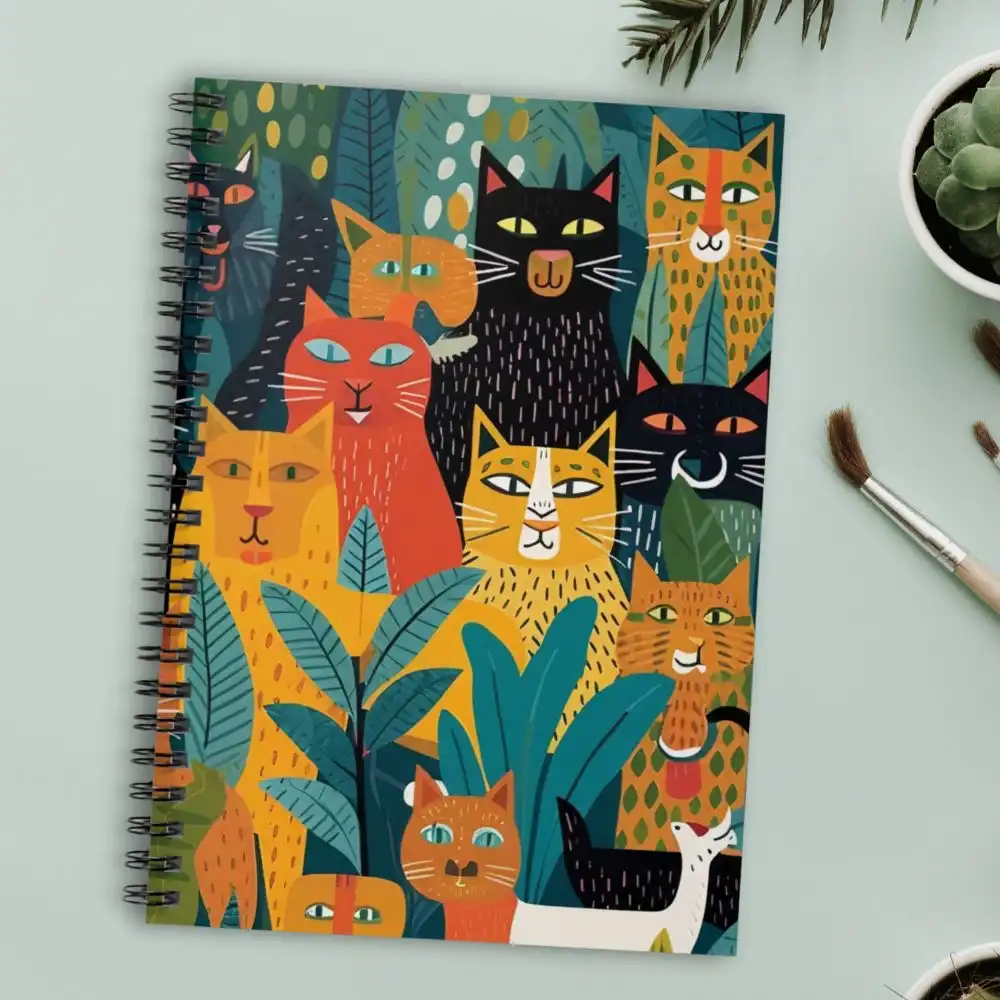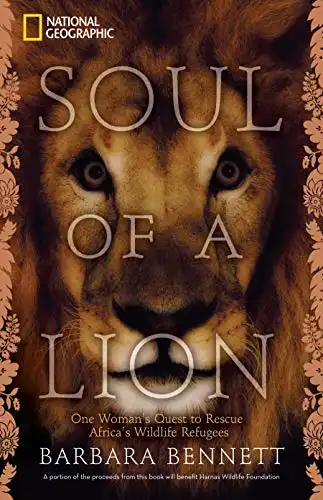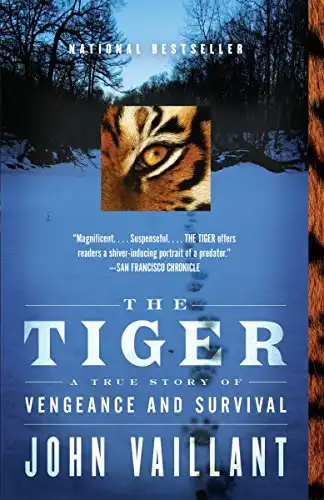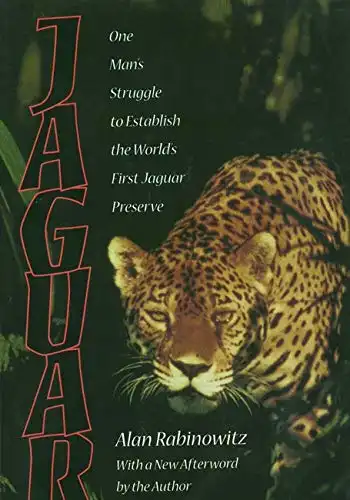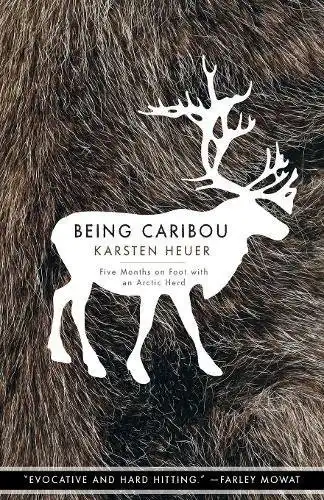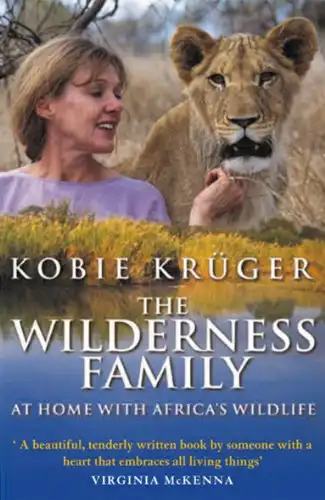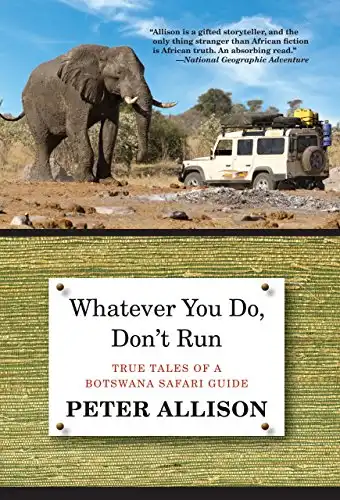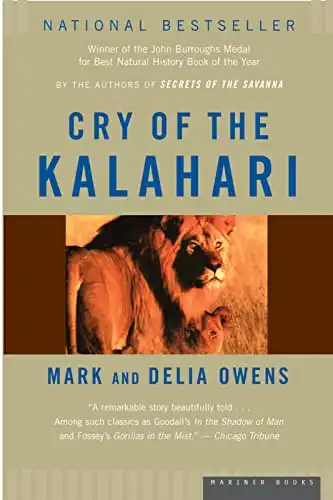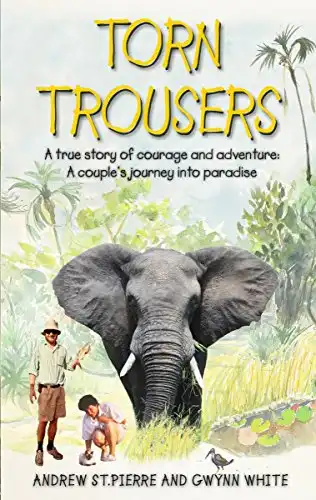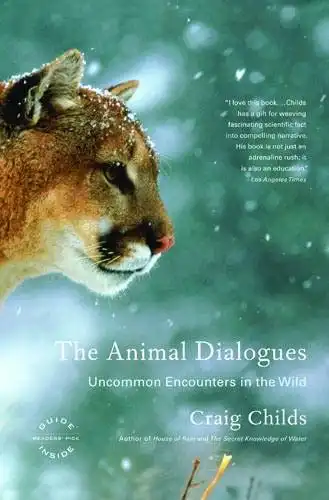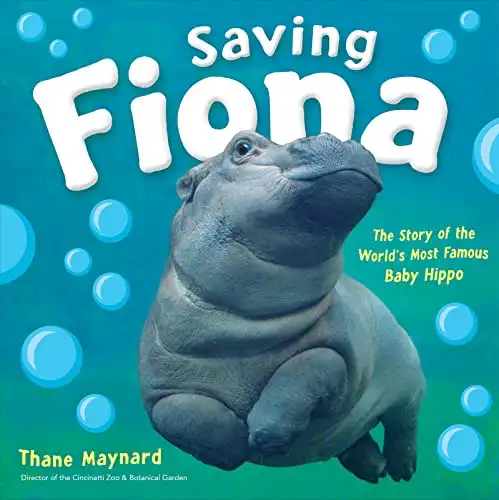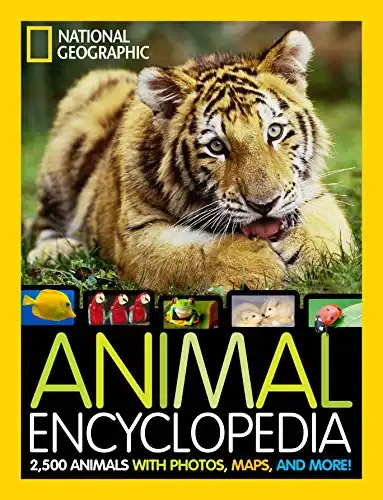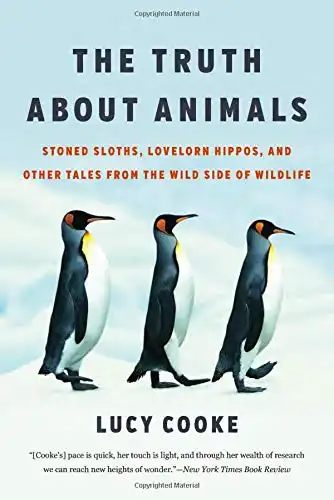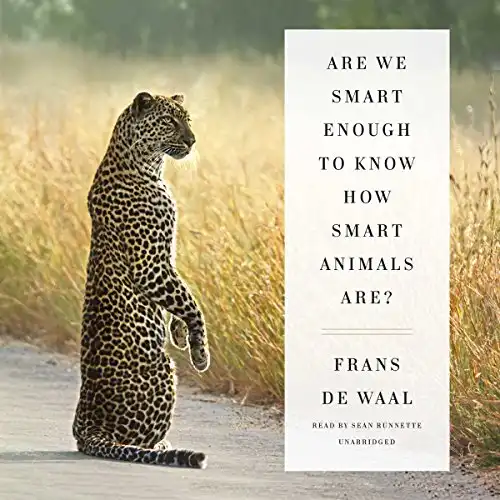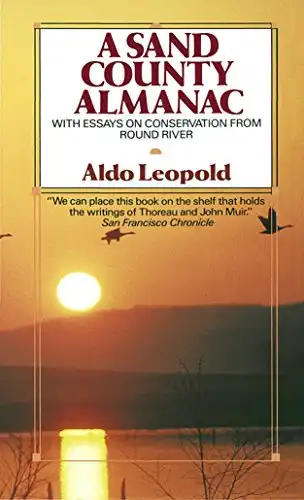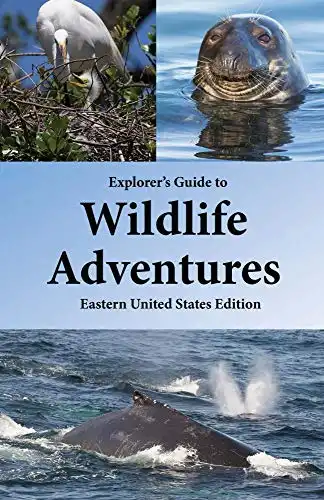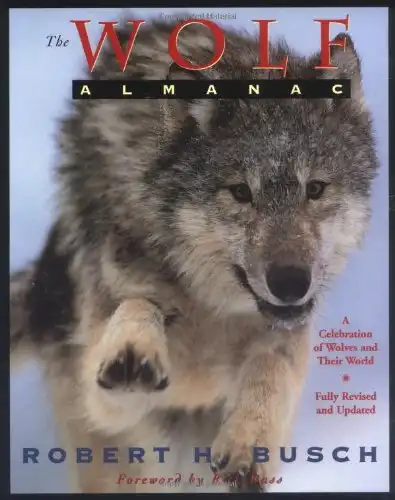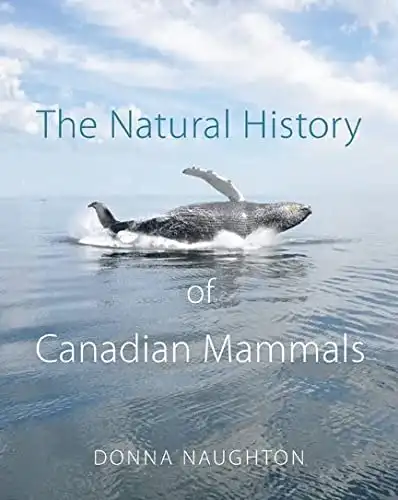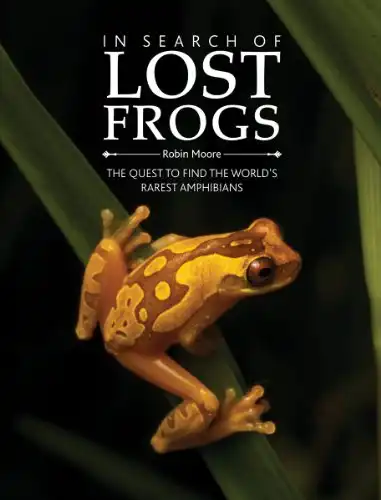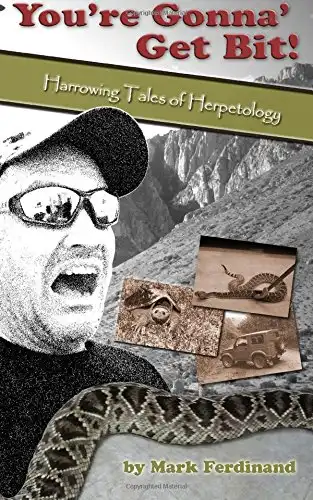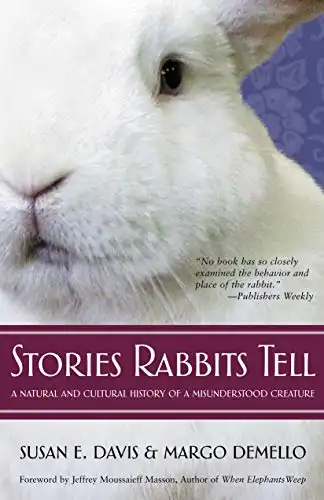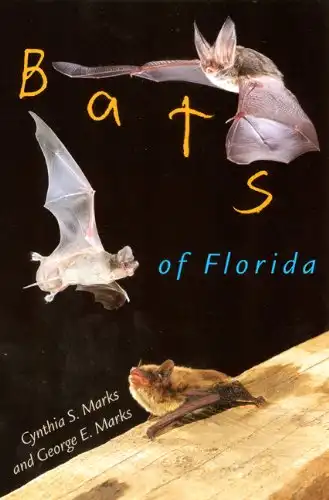Love animals? You’ll love these wildlife books that help you discover more about wildlife through engaging stories. Keep reading to see our top books about animals.
Table of Contents
I read at least one wildlife book a month. It’s my genre of choice as I naturally gravitate towards books on animals. Perhaps not all that surprising given that I have a Primatology degree, and volunteer with primates.
I find myself gravitating even more towards books about animals when times are tough. There’s something about reading about animals that makes me feel connected and realize that we’re all in this together.
And while I love observing animals in the wild, like elephants it’s not always possible. Reading about them is the next best thing. We’ve included everything in the animal kindgom from bestselling wildlife books, to books about primates, elephants, birds, sharks, big cats, oceans, and endangered species.
Check out our top recommendations for wildlife books.
Bestselling Wildlife Books At a Glance
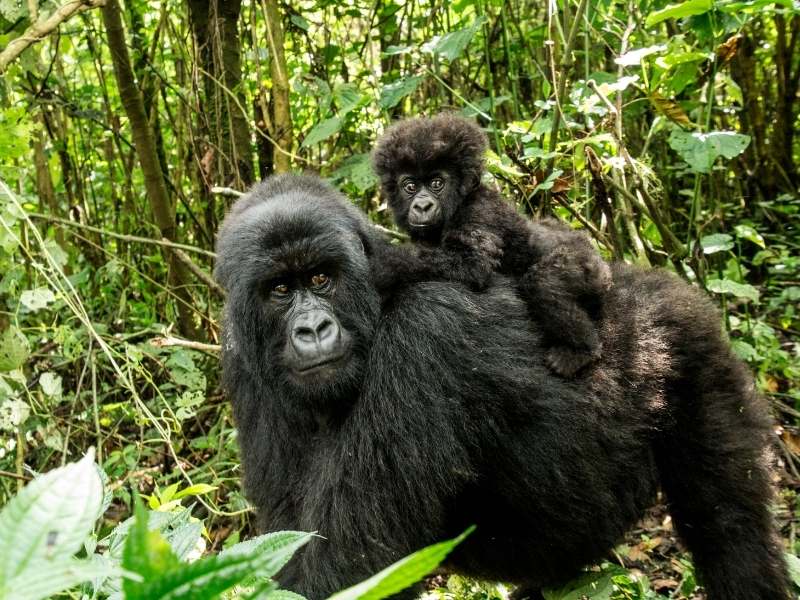
Bestselling Books About Primates
Check out the bestselling books about primates in the table below. You can see our more detailed recommendations below on chimpanzees, orangutans, gorillas, lemurs and monkeys.
More Books About Primates
Synopsis: World-renowned primatologist, conservationist, and humanitarian Dr. Jane Goodall’s account of her life among the wild chimpanzees of Gombe is one of the most enthralling stories of animal behaviour ever written. As she came to know the chimps as individuals, she began to understand their complicated social hierarchy. She observed many extraordinary behaviours. These observations forever changed our understanding of the profound connection between humans and chimpanzees.
Synopsis: In the tradition of Jane Goodall and Dian Fossey, Robert Sapolsky, a foremost science writer and recipient of a MacArthur Genius Grant, tells the mesmerizing story of his twenty-one years in remote Kenya with a troop of Savannah baboons.
“I had never planned to become a savanna baboon when I grew up; instead, I had always assumed I would become a mountain gorilla,” writes Robert Sapolsky in this witty and riveting chronicle of a scientist’s coming-of-age in remote Africa.
An exhilarating account of Sapolsky’s twenty-one-year study of a troop of rambunctious baboons in Kenya, A Primate’s Memoir interweaves serious scientific observations with wry commentary about the challenges and pleasures of living in the wilds of the Serengeti—for man and beast alike. Over two decades, Sapolsky survives culinary atrocities, gunpoint encounters, and a surreal kidnapping, while witnessing the encroachment of the tourist mentality on the farthest vestiges of unspoiled Africa. As he conducts unprecedented physiological research on wild primates, he becomes evermore enamored of his subjects—unique and compelling characters in their own right—and he returns to them summer after summer, until tragedy finally prevents him.
By turns hilarious and poignant, A Primate’s Memoir is a magnum opus from one of our foremost science writers.
WHY I LOVED READING A PRIMATES’ MEMOIR:
This book about primates is SO entertaining, informative AND endearing. It takes you on an emotional journey that will have you both laughing and crying. You’ll feel like you’ve been transported to Kenya as you meet the baboons and the Maasai tribe. This is a book that I’ve read several times and will likely read several more.
Synopsis: In 2005 Vanessa Woods accepted a marriage proposal from a man she barely knew. She agreed to join him on a research trip to the war-torn Democratic Republic of Congo.
Settling in at a bonobo sanctuary in Congo’s capital, Vanessa and her fiancé entered the world of a rare ape. An ape with whom we share 98.7% of our DNA. They live in a peaceful society in which females are in charge, war is nonexistent, and sex is as common and friendly as a handshake.
A fascinating memoir of hope and adventure. Bonobo Handshake traces Vanessa’s self-discovery as she finds herself falling deeply in love with her husband, the apes, and her new surroundings. This is a true story of revelation and transformation in a fragile corner of Africa.
WHY I ENJOYED READING BONOBO HANDSHAKE:
The book will make even the hardest cynic a lover of primates. It is a wonderful account of the lives of Congo’s bonobos and how the volatility is having a negative impact on both wildlife and human lives. Woods holds your attention with her facts and her slapstick wit while showing that we must do more to protect this highly endangered species.
Synopsis: Three women in our time have invented a revolutionary way to conduct the science of primate ethology: dedicating their lives to a single species and living as close to the earth and trees as the great apes themselves. Jane Goodall, studying the chimpanzees of Gombe; Dian Fossey, living among the mountain gorillas of the Virunga volcanoes; and Birute Galdikas, chronicling the lives of Bornean orangutans—all three women used their relationships with their study animals as tools of inquiry, and the results astonished the world.
This is a biography of the women, but also, more importantly, it is a biography of their relationships with the animals, and how those relationships changed the way we view the differences between human and non-human animals.
In researching Walking with the Great Apes, Montgomery walked the same earth as her heroines and, like them, has worked with the same apes in the wilds of Africa and Borneo. In recounting her own experiences along with those of the three brave women whose lives she evokes, she suggests what it is that their mentor, Louis Leakey, saw in them, and in the nature of women, that set Goodall, Fossey and Galdikas among the most celebrated scientists of our age.
WHY I ENJOYED READING WALKING WITH THE GREAT APES:
As someone who’s studied primatology, this is a book that has to be in my collection for obvious reasons. This book shares the inspirational stories of three women who would stop at nothing to protect the great apes, all of which are endangered species. This book about primates is a good starting point if you’re new to the natural history of apes.
From the first, it was an adventure. In 1971, at age twenty-five, Galdikas left the placid world of American academia for the remote jungles of Indonesian Borneo.
Living with her husband in a primitive camp, she became a surrogate mother to a “family” of ex-captive orangutans. She gradually adjusted to the blood-sucking leeches, swarms of carnivorous insects, and constant humidity that rotted her belongings in the first year.
A groundbreaking chronicler of the orangutans’ life cycle, Galdikas also describes the threats that increasingly menace them. The battles with poachers and loggers. And the illicit trade in infant orangutans and the frustrations of official bureaucracy.
Her story is a rare combination of personal epiphany, crucial scientific discovery, and international impact. Reflections of Eden is the third act of a drama that has captivated the world. It is a story of a pioneering primatologist, a world leader in conservation, and a remarkable woman.
WHY I ENJOYED READING REFLECTIONS OF EDEN:
Galdikas shares her real-life experiences studying and conserving orangutans. What the author goes through and how she writes about it is captivating. You’ll fall in love with these amazing apes.
When Bill Weber and Amy Vedder arrived in Rwanda to study mountain gorillas with Dian Fossey, the gorilla population was teetering toward extinction. Poaching was rampant, but it was loss of habitat that most endangered the gorillas. Weber and Vedder realized that the gorillas were doomed unless something was done to save their forest home. Over Fossey’s objections, they helped found the Mountain Gorilla Project, which would inform Rwandans about the gorillas and the importance of conservation, while at the same time establishing an ecotourism project – one of the first anywhere in a rainforest – to bring desperately needed revenue to Rwanda. In the Kingdom of Gorillas introduces readers to entire families of gorillas, from powerful silverback patriarchs to helpless newborn infants. Weber and Vedder take us with them as they slog through the rain-soaked mountain forests, observing the gorillas at rest and at play. Today the population of mountain gorillas is the highest it has been since the 1960s, and there is new hope for the species’ fragile future even as the people of Rwanda strive to overcome ethnic and political differences.
WHY I ENJOYED READING IN THE KINGDOM OF GORILLAS:
If you would like to visit Rwanda, then this is a great wildlife book to read before you see gorillas in the wild. This book gives you a view of the conservation efforts surrounding gorillas, a highly endangered species. And the many strides that Rwanda and its neighbours have made to ensure the safety of the mountain gorilla. This is one of my favourite wildlife books about gorillas.
Cheney and Seyfarth enter the minds of vervet monkeys and other primates to explore the nature of primate intelligence and the evolution of cognition.
“This reviewer had to be restrained from stopping people in the street to urge them to read it: They would learn something of the way science is done, something about how monkeys see their world, and something about themselves, the mental models they inhabit.”—Roger Lewin, Washington Post Book World
“A fascinating intellectual odyssey and a superb summary of where science stands.”—Geoffrey Cowley, Newsweek
“A once-in-the-history-of-science enterprise.”—Duane M. Rumbaugh, Quarterly Review of Biology
WHY I ENJOYED READING HOW MONKEYS SEE THE WORLD:
This is the perfect book about primates if you want to learn more about monkeys and how they perceive the natural world. It will surprise and delight you.
Wildlife Books About Elephants
Lawrence Anthony devoted his life to animal conservation, protecting the world’s endangered species. Then he was asked to accept a herd of “rogue” wild elephants on his Thula Thula game reserve in Zululand. His common sense told him to refuse, but he was the herd’s last chance of survival: they would be killed if he wouldn’t take them.
In order to save their lives, Anthony took them in. In the years that followed he became a part of their family. And as he battled to create a bond with the elephants, he came to realize that they had a great deal to teach him about life, loyalty, and freedom.
The Elephant Whisperer is a heartwarming, exciting, funny, and sometimes sad memoir of Anthony’s experiences with these huge yet sympathetic creatures. Set against the background of life on an African game reserve, with unforgettable characters and exotic wildlife, Anthony’s unrelenting efforts at animal protection and his remarkable connection with nature will inspire animal lovers and adventurous souls everywhere.
WHY I ENJOYED READING THE ELEPHANT WHISPERER:
First of all, I commend Lawrence for taking a herd of elephants that would have been sentenced to death. That in itself is inspiring. The herd not only transforms but flourishes when given a chance. This is one of my favourite books about elephants. It touches your soul and shows us the power of interspecies connection.
A conservationist who has dedicated her life to saving orphan elephants in Africa describes her relationships with late husband Tsavo Park warden David Sheldrick and a host of animals, including a dwarf mongoose, a buffalo weaver bird and the majestic elephant, Eleanor.
WHY I ENJOYED READING LOVE, LIFE & ELEPHANTS:
This is an inspiring story of a woman who achieved what was thought to be impossible in the animal kingdom. It’s an interesting read and besides giving you an insight into elephants it also offers love, inspiration and excitement.
In 2001, Sharon Pincott traded her privileged life as a high-flying corporate executive to start a new one with the Presidential Elephants of Zimbabwe. She was unpaid, untrained, self-funded and arrived with the starry-eyed idealism of most foreigners during early encounters with Africa. For thirteen years – the worst in Zimbabwe’s volatile history – this intrepid Australian woman lived in the Hwange bush fighting for the lives of these elephants, forming an extraordinary and life-changing bond with them.
Now remote from Robert Mugabe’s rule, Sharon writes without restraint sequentially through the years, taking us on a truly unforgettable ride of hope and heartbreak, profound love and loss, adversity and new beginnings. This is the haunting, all-encompassing story we’ve been waiting for.
Powerfully moving, sometimes disturbing and often very funny, Elephant Dawn is a celebration of love, courage and honour amongst our greatest land mammals. With resilience beyond measure, Sharon earns the supreme right to call them family.
WHY I ENJOYED READING ELEPHANT DAWN:
This inspiring book will have you wanting to pack up and live in the wild savannah of Africa.The author tells a compelling tale of love, survival and empathy for the largest land mammal in the animal kindgom. This is an incredible read that you won’t want to put down.
Recommended Reading: Nature Puzzles: Challenging and Beautiful Puzzles You will Love to Do
Books On Wildlife Conservation
Hordes of bloodthirsty wolves are slaughtering the arctic caribou, and the government’s Wildlife Service assigns naturalist Farley Mowat to investigate. Mowat is dropped alone onto the frozen tundra, where he begins his mission to live among the howling wolf packs and study their ways. Contact with his quarry comes quickly, and Mowat discovers not a den of marauding killers but a courageous family of skillful providers and devoted protectors of their young. As Mowat comes closer to the wolf world, he comes to fear with them the onslaught of bounty hunters and government exterminators out to erase the noble wolf community from the Arctic. Never Cry Wolf is one of the brilliant narratives on the myth and magic of wild wolves and man’s true place among the creatures of nature.
WHY I LOVED NEVER CRY WOLF:
This was the very first wildlife book I ever read, which I read when I was 14. Years later, it’s one of the most memorable books, especially one scene with a mouse. That’s saying a lot given how much I read. It’s also one of the most impactful for changing our perceptions about such a maligned and misunderstood species.
After reading this, it’s hard to justify the senseless culling of wolves that takes place throughout North America. Pacific Wild shares how you can help save wolves and stop the wolf hunt.
The intimate, involving story of the rise and reign of O-Six, the fabled Yellowstone wolf, and the people who loved or feared her. For readers of H is for Hawk, captivating works of reportage, and iconic books on the American West.
Before humans ruled the Earth, there were wolves. Once abundant in the United States, these majestic creatures were hunted to near extinction by the 1920s. But in recent decades, conservationists have brought wolves from Canada back to Yellowstone National Park, igniting a battle over the very soul of the American West.
With novelistic detail, Nate Blakeslee tells the gripping story of one of these wolves, a charismatic alpha female named O-Six. She’s a kind and merciful leader, a fiercely intelligent fighter, and a doting mother. Beloved by wolf watchers, particularly Yellowstone park ranger Rick McIntyre, O-Six becomes something of a social media star, with followers around the world.
WHY I ENJOYED READING AMERICAN WOLF:
The book acquaints the reader with the beauty of the Yellowstone wolf. It traces the history of this elusive animal and the challenges it faces. This book will have you wanting to look for wolves in the wild – not an easy task considering how small their populations are.
When Terri Raines was twenty-seven years old, she took a vacation that changed her life. Leaving behind her wildlife rescue work in Oregon, Terri traveled to Australia, and there, at a small wildlife park, she met and fell in love with a tall, blond force of nature named Steve Irwin. They were married in less than a year, and Terri eagerly joined in Steve’s conservation work. The footage filmed on their crocodile-trapping honeymoon became the first episode of The Crocodile Hunter, and together, Steve and Terri began to change the world.
In Steve & Me, Terri recounts the unforgettable adventures they shared — wrangling venomous snakes, saving deadly crocodiles from poachers, swimming among humpback whales. A uniquely gifted naturalist, Steve was first and foremost a wildlife warrior dedicated to rescuing endangered animals — especially his beloved crocs — and educating everyone he could reach about the importance of conservation. In the hit TV shows that continue to be broadcast worldwide, Steve’s enthusiasm lives on, bringing little-known and often-feared species to light as he reveals and revels in the wonders of our planet.
With grace, wit, and candor, Terri Irwin portrays her husband as he really was — a devoted family man, a fervently dedicated environmentalist, a modest bloke who spoke to millions on behalf of those who could not speak for themselves. Steve & Me is a nonstop adventure, a real-life love story, and a fitting tribute to a man adored by all those whose lives he touched, written by the woman who knew and loved him best of all.
WHY I ENJOYED READING STEVE & ME:
Technically this is not a book about wildlife but rather one about the most famous wildlife conservationists in the world. The book is written by Steve Irwin’s wife who recounts the story of their meeting. It offers great insight into what it takes to become a conservationist.
When Lawrence Anthony, author of The Elephant Whisperer, cared for not only elephants but other types of wildlife, including rhinos, on his nature reserve. So when he learned that there were only a handful of northern white rhinos left in the wild, living in an area of the Congo controlled by the infamous Lord’s Resistance Army, he was determined to save them from extinction. If the world lost this subspecies of rhinoceros, it would be the largest land mammal since the woolly mammoth to go extinct, a tragedy for those who care about the world’s endangered species.
What followed was an extraordinary adventure, as Anthony headed into the jungle to ask the rebels to help protect the rhino. Sometimes funny, sometimes moving, and always exciting, The Last Rhinos tells the story of his fight to save these remarkable creatures.
WHY I ENJOYED READING THE LAST RHINOS:
The book is not only about rhinos but also the way that politics and wars can affect wildlife. It’s full of adventure and takes a look at a different way humans impact nature, rhinos, and other wildlife. A must-read for anyone interested in books on wildlife conservation.
Synopsis: In this eloquent plea for compassion and respect for all species, journalist and gardener Nancy Lawson describe why and how to welcome wildlife to our backyards.
Through engaging anecdotes and inspired advice, profiles of home gardeners throughout the country, and interviews with scientists and horticulturalists, Lawson applies the broader lessons of ecology to our own outdoor spaces.
WHY I ENJOYED READING THE HUMANE GARDENER:
The Humane Gardener is well-written and engaging. It is a great way to learn more about how we can make our gardens a safe haven for wildlife. I liked that it advocates for being more responsible and mindful of how we care for our own spaces, literally in our own backyard. It’s a fun and informative read, and reminds us that can all play a positive role in species conservation.
Our insatiable demand for animals – for jewelry, pets, medicine, meat, trophies, and fur – is driving a worldwide poaching epidemic, threatening the continued existence of countless species.
Illegal wildlife trade now ranks among the largest contraband industries in the world, yet compared to a drug, arms, or human trafficking, the wildlife crisis has received scant attention and support, leaving it up to passionate individuals fighting on the ground to try to ensure that elephants, tigers, rhinos, and more are still around for future generations.
WHY I ENJOYED READING POACHED:
Poaching has been increasing more than ever over the last decade. This book was an insightful reminder of what havoc poaching causes, not only resulting in countless of endangered species but also to humans. It is one of those wildlife books that makes you mindful of your surroundings and think about things that you would not normally think of. It’s not a fun read, but it’s an important conservation book on animal conservation.
Andrew Mack immersed himself in a vast expanse of roadless, old-growth rainforest of Papua New Guinea in 1987.
He and his co-investigator Debra Wright built a research station by hand and lived there for years. Their mission was to study the secretive and perhaps most dinosaur-like creature still roaming the planet: the cassowary.
The ensuing adventures of this unorthodox biologist–studying seeds found in cassowary droppings (pekpek), learning to live among the indigenous Pawai’ia, traversing jungles, fighting pests and loneliness, struggling against unscrupulous oil speculators, and more–are woven into a compelling tale that spans two decades.
Mack shares the insights he garnered about rainforest ecology while studying something as seemingly mundane as cassowary pekpek. He ultimately gained profound insight into why conservation is failing in places like Papua New Guinea and struggled to create a more viable strategy for conserving some of Earth’s last wild rainforests.
WHY I ENJOYED READING SEARCHING FOR PEKPEK:
This wildlife book is adventurous and exciting and makes for an excellent read. Find out more about the remote tribes of Papua New Guinea and the importance of conserving this wonderful country. The book is inspiring, funny and sad in some places, but it’s hard to put down once you start reading it.
In Italian, there is no word for wilderness. Yet in the mountains of Italy, brown bears not only exist, they are fighting to survive amid encroaching development, local and international politics, and the mafia.
This meticulously researched and eye-opening book tells the incredible stories of two special populations of bears in Italy–one the last vestige of a former time that persists against all odds, the other a great experiment in rewilding that, if successful, promises to change how we see not only Italy but all of Europe.
WHY I ENJOYED READING NO WORD FOR WILDERNESS:
Did you know that Italy is home to grizzly bears? Most people don’t. This wildlife book will give you an insight into one of the rarest bears in the world. The dangers these bears face are real and extinction is inevitable if they are not protected. Find out what’s being done to take care of Italian grizzly’s and how they can be saved.
In Wilding, Isabella Tree tells the story of the ‘Knepp experiment’, a pioneering rewilding project in West Sussex, using free-roaming grazing animals to create new habitats for wildlife. Part gripping memoir, part fascinating account of the ecology of our countryside, Wilding is, above all, an inspiring story of hope.
Forced to accept that intensive farming on the heavy clay of their land at Knepp was economically unsustainable, Isabella Tree and her husband, Charlie Burrell, made a spectacular leap of faith: they decided to step back and let nature take over. Thanks to the introduction of free-roaming cattle, ponies, pigs and deer – proxies of the large animals that once roamed Britain – the 3,500-acre project has seen extraordinary increases in wildlife numbers and diversity in little over a decade.
Extremely rare species, including turtle doves, nightingales, peregrine falcons, lesser spotted woodpeckers and purple emperor butterflies, are now breeding at Knepp, and populations of other species are rocketing. The Burrells’ degraded agricultural land has become a functioning ecosystem again, heaving with life – all by itself.
WHY I ENJOYED READING WILDING:
In a world that has become about production, Isabella and her husband Charlie decide to take a new route to sustain their farmlands. This book is a great reminder that we can make a positive impact on conservation if we put our minds to it.
Over the last half a billion years, there have been five mass extinctions, when the diversity of life on earth suddenly and dramatically contracted. Scientists around the world are currently monitoring the sixth extinction, predicted to be the most devastating extinction event since the asteroid impact that wiped out the dinosaurs.
This time around, the cataclysm is us. In The Sixth Extinction, two-time winner of the National Magazine Award and New Yorker writer Elizabeth Kolbert draws on the work of scores of researchers in half a dozen disciplines, accompanying many of them into the field: geologists who study deep ocean cores, botanists who follow the tree line as it climbs up the Andes, marine biologists who dive off the Great Barrier Reef.
She introduces us to a dozen species, some already gone, others facing extinction, including the Panamian golden frog, staghorn coral, the great auk, and the Sumatran rhino. Through these stories, Kolbert provides a moving account of the disappearances occurring all around us and traces the evolution of extinction as concept, from its first articulation by Georges Cuvier in revolutionary Paris up through the present day.
WHY I ENJOYED READING THE SIXTH EXTINCTION:
The Sixth Extinction is an eye-opener. It made me realize just how many endangered species there are. Winner of the coveted Pultizer Prize and rave reviews it’s a must read for all animal lovers – even if it’s not the easiest read on our list.
In Eager, environmental journalist Ben Goldfarb reveals that our modern idea of what a healthy landscape looks like and how it functions is wrong, distorted by the fur trade that once trapped out millions of beavers from North America’s lakes and rivers.
The consequences of losing beavers were profound: streams eroded, wetlands dried up, and species from salmon to swans lost vital habitat. Today, a growing coalition of “Beaver Believers” – including scientists, ranchers, and passionate citizens – recognizes that ecosystems with beavers are far healthier, for humans and non-humans alike than those without them.
From the Nevada deserts to the Scottish highlands, Believers are now hard at work restoring these industrious rodents to their former haunts.
WHY I ENJOYED READING EAGER:
This book offers insight into the lives of beavers. Explore the many challenges that beavers have faced through the centuries. These furry and beautiful rodents are precious to the environment and deserve to have recognition which this book gives them. You won’t want to miss this wildlife book.
Though nature is indifferent to the struggles of her creatures, the human effect on them is often premeditated.
The distressing decline of sea turtles in Pacific waters and their surprising recovery in the Atlantic illuminate what can go both wrong and right from our interventions, and teach us the lessons that can be applied to restore health to the world’s oceans and its creatures.
As Voyage of the Turtle, Carl Safina’s compelling natural history adventure makes clear, the fate of the astonishing leatherback turtle, whose ancestry can be traced back 125 million years, is in our hands.
WHY I ENJOYED READING VOYAGE OF THE TURTLE:
This is a great read. It is compelling and gives you some great insights into the world of turtles and the dangers they face. I have always found the sea turtle fascinating and beautiful, but after reading this book I have found a new appreciation for these wondrous animals. This wildlife book also sheds light on the many ways in which organizations are working to protect sea turtles.
With more than 7.5 billion people on the planet, wildlife is going extinct at the fastest rate since the dinosaurs.
Three to four million dogs and cats are killed in shelters every year; billions of chickens, pigs, and cows are killed for food; and countless animals are killed in research labs or their habitat. The numbers are daunting, but there’s good news too! Even one person truly can make a difference without breaking the bank.
WHY I ENJOYED READING THE ANIMAL LOVER’S GUIDE TO CHANGING THE WORLD:
This book is a wake-up call and will make you reconsider how you think of wildlife and what we all should be doing to help save the planet. The numbers are daunting but there is hope. This wildlife book will give you the tools you need to be more considerate and helpful in fighting extinction. It was a great read and I took away so much from it.
More Wildlife Books
Books About Birds
When Helen Macdonald’s father died suddenly on a London street, she was devastated. An experienced falconer—Helen had been captivated by hawks since childhood—she’d never before been tempted to train one of the most vicious predators, the goshawk.
But in her grief, she saw that the goshawk’s fierce and feral temperament mirrored her own. Resolving to purchase and raise the deadly creature as a means to cope with her loss, she adopted Mabel and turned to the guidance of The Once and Future King author T.H. White’s chronicle The Goshawk to begin her challenging endeavour.
Projecting herself “in the hawk’s wild mind to tame her” tested the limits of Macdonald’s humanity and changed her life.
WHY I ENJOYED READING H IS FOR HAWK:
H is for Hawk is a wonderful story of how birds and humans can interact in a manner that is of benefit to both. This book was a great way to learn about hawks and how amazingly intelligent they really are. The bond between Helen and her hawk, Mabel, is truly inspiring.
As the author travels around the world to the most cutting-edge frontiers of research, Ackerman not only tells the story of the recently uncovered genius of birds but also delves deeply into the latest findings about the bird brain itself that are shifting our view of what it means to be intelligent.
At once personal yet scientific, richly informative and beautifully written, The Genius of Birds celebrates the triumphs of these surprising and fiercely intelligent creatures.
WHY I ENJOYED READING THE GENIUS OF BIRDS:
This was the book that made me reconsider the term “Bird Brain”. Just because something is small doesn’t mean that they are not mighty in their own way. You will enjoy the fresh way the author looks at the intelligence of birds. This is a wonderful wildlife book.
Birds are highly intelligent animals, yet their intelligence is dramatically different from our own and has been little understood. As we learn more about the secrets of bird life, we are unlocking fascinating insights into memory, relationships, game theory, and the nature of intelligence itself.
The Thing with Feathers explores the astonishing homing abilities of pigeons, the good deeds of fairy-wrens, the influential flocking abilities of starlings, the deft artistry of bowerbirds, the extraordinary memories of nutcrackers, the lifelong loves of albatrosses, and other mysteries—revealing why birds do what they do, and offering a glimpse into our own nature.
Drawing deep from personal experience, cutting-edge science, and colourful history, Noah Strycker spins captivating stories about the birds in our midst and shares the startlingly intimate coexistence of birds and humans. With humour, style, and grace, he shows how our view of the world is often, and remarkably, through the experience of birds. You’ve never read a book about birds like this one.
WHY I ENJOYED READING THE THING WITH FEATHERS:
This is a book full of lighthearted humour and really fascinating facts that you have probably never thought of. I have read a lot of wildlife books, but this is one of my favourites about birds.
In Mind of the Raven, Bernd Heinrich, award-winning naturalist, finds himself dreaming of ravens and decides he must get to the truth about this animal reputed to be so intelligent.
Much like a sleuth, Heinrich involves us in his quest, letting one clue lead to the next. But as animals can only be spied on by getting quite close Heinrich adopts ravens, thereby becoming a “raven father,” as well as observing them in their natural habitat, studying their daily routines, and in the process painting a vivid picture of the world as lived by the ravens.
At the heart of this book are Heinrich’s love and respect for these complex and engaging creatures, and through his keen observation and analysis, we become their intimates too.
Throughout history, there has existed an extraordinary relationship between humans and ravens.
Ravens, like early humans, are scavengers on the kills of great carnivores. As scavengers, ravens were associated with hunters they found in the north: wolves and, later, men.
The trinity of wolf, man, and raven in the hunt is an extremely ancient one. In considering the appeal of the raven, Bernd Heinrich suspects that a meeting of the minds might reside in that hunting trinity.
WHY I ENJOYED READING MIND OF THE RAVEN:
I have to admit that I thought that this book would not be my cup of tea. But as I continued reading, I was surprised that I was actually interested in what the author had to say about ravens. I had never considered how intelligent they really are and the author does a good job getting that fact across.
Over 9,000 species, the most widespread of all animals: on icebergs, in the Sahara or under the sea, at home in our gardens or flying for over a year at a time.
Earthbound, we can only look and listen, enjoying their lightness, freedom and richness of plumage and song.
David Attenborough has been watching and learning all his life. His new book, with its accompanying series of films for BBC TV, is a brilliant introduction to bird behaviours around the world: what they do and why they do it.
He looks at each step in birds’ lives and the problems they have to solve: learning to fly; finding food; communicating; mating and caring for nests, eggs and young; migrating; facing dangers and surviving harsh conditions.
WHY I ENJOYED READING THE LIFE OF BIRDS:
I am a huge David Attenborough fan. It was a fun book to read that was full of really useful information about birds. It may even inspire a birdwatching hobby.
As a young woman, Sharon Matola lived many lives. She was a mushroom expert, an Air Force survival specialist, and an Iowa housewife. Sharon hopped freight trains for fun and starred as a tiger tamer in a travelling Mexican circus.
Finally, she found her one true calling: caring for orphaned animals at her own zoo in the Central American country of Belize.
Beloved as “the Zoo Lady” in her adopted land, Matola became one of Central America’s greatest wildlife defenders.
And when powerful outside forces conspired with the local government to build a dam that would flood the nesting ground of the last scarlet macaws in Belize, Sharon Matola was drawn into the fight of her life.
WHY I ENJOYED READING THE LAST FLIGHT OF THE SCARLET MACAW:
Matola is inspirational in her need to help save animals – both individuals and at a species level. Her excitement shines through, although she also gets into politics quite a bit.
Recommended Reading: The Best Books To Read Before You Travel
Best Wildlife Photography Books
Synopsis: For filmmaker Rob Stewart, exploring sharks began as an underwater adventure. What it turned into was a beautiful and dangerous life journey into the balance of life on earth.
Driven by passion fed from a lifelong fascination with sharks, Stewart debunks historical stereotypes and media depictions of sharks as bloodthirsty, man-eating monsters, and reveals the reality of sharks as pillars in the evolution of the seas.
WHY I ENJOYED READING SHARKWATER PHOTO BOOK:
I first saw the Sharkwater film and then bought this beautiful coffee table picture book to remind me of the beauty of sharks. It was this movie and book that inspired me to try shark diving for myself.
Sharkwater is incredibly impactful and debunks the myth of sharks as the man-eating machines that they’ve been depicted as in JAWS and in the media. Sharks are in jeopardy of being driven to extinction because of the cruel practice of shark finning and this book shows you how unsustainable it is and how stopping it would have a huge positive conservation impact on sharks.
I’m convinced that shark tourism can be part of the conservation solution which shows that sharks are worth more alive than dead.
WHY I ENJOYED READING WILD ENCOUNTERS:
I love animal photography books, especially when I’m having a bad day. They remind me how incredible our natural world really is.
Wildlife of the World takes you on a journey through some of the most scenic and rich animal habitats — from the Amazon rain forests to the Himalayas, the Sahara to the South Pole — meeting the most important animals in each ecosystem along the way.
In Wildlife of the World truly spectacular portrait-style photography brings you “face-to-face” with individual animals in up-close and engrossing profiles on how the animals interact with their environments, mate, survive, and even play.
From the shaggy musk ox foraging in the Canadian high arctic to the angered Scottish wildcat prowling the Highlands to the rock-climbing gelada monkey of Ethiopia, each animal featured in Wildlife of the World plays a key role in its environment. An additional eighty-page illustrated reference section on the animal kingdom explains the animal groups and profiles additional species.
WHY I ENJOYED READING WILDLIFE OF THE WORLD:
This wildlife photography book is great for the whole family. I loved that the facts are simple and fun and that the images are really vibrant. This is the perfect book for teaching your kids fun facts new about animals.
Books About the Ocean
Synopsis In pursuit of the wild, solitary, predatory octopus, popular naturalist Sy Montgomery has practiced true immersion journalism.
From New England aquarium tanks to the reefs of French Polynesia and the Gulf of Mexico, she has befriended octopuses with strikingly different personalities—gentle Athena, assertive Octavia, curious Kali, and joyful Karma.
Each creature shows her cleverness in myriad ways: escaping enclosures like an orangutan; jetting water to bounce balls, and endlessly tricking companions with multiple “sleights of hand” to get food.
Scientists have only recently accepted the intelligence of dogs, birds, and chimpanzees but now are watching octopuses solve problems and are trying to decipher the meaning of the animal’s colour-changing techniques.
With her “joyful passion for these intelligent and fascinating creatures” (Library Journal Editors’ Spring Pick), Montgomery chronicles the growing appreciation of this mollusk as she tells a unique love story. By turns funny, entertaining, touching, and profound, The Soul of an Octopus reveals what octopuses can teach us about the meeting of two very different minds.
WHY I ENJOYED READING THE SOUL OF AN OCTOPUS:
The book gives you exactly what the title promises, a look into the soul of an octopus. Sy Montgomery opens your eyes and mind to the wonderful intelligence of the octopus and the connections they are able to make with humans. I love books like this that give you a different perspective of a species as this one does.
Humans and dolphins have a unique bond. We know that dolphins are highly intelligent, intensely sociable beings who recognize their own reflections. They introduce themselves by name, form close friendships, communicate constantly, feel despondent, rescue one another (and humans). Dolphins can deduce, infer, throw tantrums, gossip, joke, and scheme.
Many who have swum with them describe the experience as life-changing. They are heralded as magical creatures, and yet we force them into starring roles at theme parks, trade them on the black market and put them to slaughter.
WHY I ENJOYED READING VOICES IN THE OCEAN:
Don’t look for anything soft or sentimental in this wildlife book. It is a hard look at the reality of the negative impact humans are having on dolphins. But also contains fascinating facts about dolphins.
Jellyfish are the oldest multi-organed life form on the planet, having inhabited the ocean for more than five hundred million years. With their undulating umbrella-shaped bells and sprawling tentacles, they are compelling and gorgeous, strange and dangerous.
In many places, they’re also vastly increasing in number. And these population blooms may be an ominous indicator of the rising temperatures and toxicity of the oceans.
Jellyfish presents these aquarium favourites in all their glory.
Fifty unique species, from the purple people eater to black sea nettles, are presented in stunning photos along with the most current scientific information on their anatomy, history, distribution, position in the water, and environmental status.
Foremost jellyfish expert Lisa-ann Gershwin provides an insightful look at the natural history and biology of each of these spellbinding creatures, plus a timely take on their place in the rapidly changing and deteriorating condition of the oceans.
WHY I ENJOYED READING JELLYFISH:
Jellyfish is a great book that will help you understand the real impact of jellyfish in the world. This book is a great guide to the different types of jellyfish and their history in the oceans. The book has wonderful wildlife images not to be missed.
Before there were mammals on land, there were dinosaurs. And before there were fish in the sea, there were cephalopods – the ancestors of modern squid and Earth’s first truly substantial animals.
Cephalopods became the first creatures to rise from the seafloor, essentially inventing the act of swimming. With dozens of tentacles and formidable shells, they presided over an undersea empire for millions of years.
But when fish evolved jaws, the ocean’s former top predator became its most delicious snack. Cephalopods had to step up their game.
Many species streamlined their shells and added defensive spines, but these enhancements only provided a brief advantage.
Some cephalopods then abandoned the shell entirely, which opened the gates to a flood of evolutionary innovations: masterful camouflage, fin-supplemented jet propulsion, perhaps even dolphin-like intelligence.
WHY I ENJOYED READING SQUID EMPIRE:
Admittedly I was sceptical before reading this book. Especially since it is written by a scientist and I thought it would be an academic approach to the natural world. I was pleasantly surprised to find that the book is actually quite light-hearted and the scientific explanations are easy to understand.
This is the heartbreaking and true story of a lonely orca named Luna who befriended humans in Nootka Sound, off the coast of Vancouver Island. One summer in Nootka Sound a young killer whale named Luna got separated from his pod.
Like humans, orcas are highly social and depend on their families, but Luna found himself desperately alone. So he tried to make contact with people. He begged for attention at boats and docks. Luna looked soulfully into people’s eyes. He wanted to have his tongue rubbed. When someone whistled at him, he squeaked and whistled back.
People fell in love with him. But the government decided that being friendly with Luna was bad for him. And they tried to keep him away from humans. Policemen arrested people for rubbing Luna’s nose. Then fines were levied.
Undaunted, Luna refused to give up his search for connection. And people went out to meet him, like smugglers carrying friendship through the dark. But does friendship work between species? However, people who loved Luna couldn’t agree on how to help him. Then conflict came to Nootka Sound.
The government built a huge net. Then the First Nations’ members brought out their canoes. However, nothing went as planned. And the ensuing events caught everyone by surprise. It challenged the very nature of that special and mysterious bond we humans call friendship.
WHY I ENJOYED READING THE LOST WHALE:
This is a heartwarming book. It looks at how relationships and bonds can form between humans and animals. I always enjoy a book that makes me not only think, but feel for the subject of the story. This is one of those wildlife books that makes you aware of how animals are able to feel emotions similar to humans.
Recommended Reading: Hiking Quotes to Give You The Inspiration You Need
Wildlife Books About Big Cats
OK, while it's technically not a book, our jungle cat spiral notebook featuring big cats will get your creativity roaring and will become your go-to for capturing fierce thoughts and untamed dreams. It also makes a great reading journal.
Synopsis: For animal lovers, nature enthusiasts, and the vast readership for gripping true-life stories, this African saga is a must-read adventure.
It chronicles the unique Harnas Wildlife Foundation in Namibia. Here Marieta van der Merwe and her family, former wealthy cattle farmers, have sold the land to buy and care for embattled wildlife.
We meet Sam, the “AIDS” lion infected by mistake at a vet clinic. Boerjke, a baboon with epilepsy and Down syndrome. Savanna, the one-eyed lioness. And Marieta van der Merwe herself, the inspiring proprietor of Harnas who shares her home with needy wild animals.
Survivor of an early life fraught with personal tragedy in the African Bush, she now devotes herself as care-giver and ambassador for wildlife and wildland.
Told with insight, humour, and thrilling immediacy by the author, this story will truly captivate readers of all ages.
WHY I LOVED READING SOUL OF A LION:
If I could only read five wildlife books for the rest of my life, this would be one of them. The stories of love and connection are incredibly impactful.
One story between a baboon and a goat will have you in heartfelt tears. You’ll truly find yourself saying awww and wow, multiple times throughout this book. It’s incredibly impactful for understanding the power of love across species.
Synopsis: Outside a remote village in Russia’s Far East a man-eating tiger is on the prowl. The tiger isn’t just killing people. It’s murdering them, almost as if it has a vendetta. A team of trackers is dispatched to hunt down the tiger before it strikes again.
They know the creature is cunning, injured, and starving, making it even more dangerous. As John Vaillant re-creates these extraordinary events, he gives us an unforgettable and masterful work of narrative nonfiction. He not only portrays a riveting portrait of a stark and mysterious region of the world and its people. But the natural history of nature’s most deadly predator.
WHY I ENJOYED READING THE TIGER: A TRUE STORY OF VENGEANCE & SURVIVAL:
This book gives a chilling insight into the natural world in Siberia. I found it easy to forget that this was a non-fiction book. Vaillant is truly an excellent story-teller. You will find yourself loving and hating the men that hunt the tiger. But a part of you will sympathize with these men too as he shares the human tiger conflict.
In 1983, zoologist Alan Rabinowitz ventured into the rain forest of Belize. He was determined to study the little-known jaguar in its natural habitat. And to establish the world’s first jaguar preserve. Within two years, he had succeeded.
In Jaguar he provides the only first-hand account of a scientist’s experience with jaguars in the wild. Jaguar presents an irresistible blend of natural history and adventure. Intensely personal, it is a portrait of an elusive, solitary predator and the Mayas with which it shares the jungle.
WHY I ENJOYED READING JAGUAR:
Can you imagine living in the wild with Jaguars? Littered with great information, daring feats and dangerous situations, this book takes you into jaguar habitat. Big cat lovers will relish this book.
Recommended Reading: Gifts for the Animal Lover in Your Life
Wildlife Adventure Books
Synopsis: For aeons, female members of the Porcupine caribou herd have made the 2,800-mile journey from their winter feeding grounds to their summer calving grounds. They once roamed the borderless wilderness. Now they trek from Canada, where they’re protected, to the United States, where they are not.
What’s more, beneath the calving grounds lay vast reserves of oil. Determined to convey both the enormity of the Caribous’ migration and the delicacy of their habitat, Karsten Heuer and his wife spent their honeymoon following the herd.
For five months, they travelled an uncharted course on foot over mountains, through snow, and across frozen rivers. All this with only three semi-scheduled food drops for support.
As with the caribou, Heuer and his wife faced dwindling fat reserves. And stalking by ravenous grizzlies and wolves just awakened from hibernation. Both a rousing adventure story and a sober ecological meditation, Being Caribou vividly conveys this magnificent animal’s world.
WHY I ENJOYED READING ABOUT BEING CARIBOU:
Caribou don’t have the wow factor that some animals like pandas have. Before reading this book I had a mild interest in them at most.
However, I found caribou and Karsten’s journey to be fascinating! I had no idea just how sensitive they were. If you enjoy the book, I highly recommend the Being Caribou DVD. I think it’s even better than the book and I’ve also had the pleasure of hearing him speak about his epic adventure.
After reading this book, not only will you never think of caribou the same again. And you might actually think of them.
Synopsis: Everyone warned Kobie Krüger that being the wife of a game warden at a remote ranger station in South Africa’s largest national park would be an arduous move.
The heat was unbearable. Malaria would be a constant danger. Her husband would have to be away for long stretches. And there were no schools or nearby doctors for their three daughters. The area was also teeming with wild animals.
Yet for Kobie and her family, the seventeen years at South Africa’s Kruger National Park were the most magical of their lives.
Now, in The Wilderness Family, Kobie recounts their enchanting adventures and extraordinary encounters.
WHY I ENJOYED READING THE WILDERNESS FAMILY:
I’ve read this book at least 5 times and keep coming back to it. How would you deal with a resident cobra at your doorstep?
Or being isolated for months at a time? Keeping your family safe from floods? Kobie brings Africa to life in a way that few of us will ever know with her brilliant storytelling. I’ve made all my book clubs over the years read this book as I think it’s one of the best wildlife books out there – especially for people that don’t normally read about natural history.
Synopsis: A hilarious, highly original collection of essays based on the Botswana truism: “only food runs!” With a new introduction and new material from the author.
In the tradition of Bill Bryson, a new writer brings us the lively adventures and biting wit of an African safari guide. Peter Allison gives us the guide’s view of living in the bush. He confronts the world’s fiercest terrain of wild animals and, most challenging of all manages herds of gaping tourists.
Passionate for the animals of the Kalahari, Allison works as a top safari guide in the wildlife-rich Okavango Delta. As he serves the whims of his wealthy clients, he often has to stop the impulse to run as far away from them as he can. These tourists are sometimes more dangerous than a pride of lions.
WHY I ENJOYED READING WHATEVER YOU DO, DON’T RUN:
This book has laugh-out-loud moments. It will leave you wondering whether we’re really the smartest creatures on the planet. I truly recommend this entertaining wildlife read before going on safari.
Synopsis: The story follows two young Americans, Mark and Delia Owens who carrying little more than a change of clothes and a pair of binoculars, caught a plane to Africa. They then bought a thirdhand Land Rover, and drove deep into the Kalahari Desert.
There they lived here for seven years. In an unexplored area with no roads, no people, and no source of water for thousands of square miles. In this vast wilderness, the Owenses began their zoology research. They worked alongside animals that had never before been exposed to humans.
Cry of the Kalahari is the story of the Owens’ life with lions, brown hyenas, jackals, giraffes, and the many other creatures they came to know. It is also a gripping account of how they survived the dangers of living in one of the last and largest pristine areas on Earth.
WHY I ENJOYED READING CRY OF THE KALAHARI:
I enjoyed reading about Mark & Delia’s adventures with wildlife in the Kalahari and found their courage and survival skills awe-inspiring. Their experiences take the concept of adventure travel to new heights.
Tired of mortgage payments, thirty-something Andrew and Gwynn sold nearly everything they owned but their Siamese cat. They escaped their humdrum nine-to-five existence for life in paradise. A tiny island accessible only by boat or air in one of the remotest spots on Earth: the Okavango Delta in Botswana.
Woefully inexperienced, they took control of a luxury game lodge. The lodge catered to the likes of French aristocrats, Hollywood directors, Mafia lawyers, and the captain of the England cricket team. And not forgetting the hippos who liked to crash cocktail hour.
Trouble soon followed as the reality of running a hotel on an island burst upon them. Andrew and Gwynn learn it’s one thing for guests to wake up with gentle giraffes outside their windows, but it’s quite another to keep them safe from poisonous snakes, temperamental elephants, and a hyena with a taste for plastic.
All that was child’s play compared to figuring out how to feed their guests. Especially when a ‘quick run’ to the grocery store required a plane, a bush pilot, and moderate risk to life, limb, and property.
WHY I ENJOYED READING TORN TROUSERS:
This adventurous book reads more like fiction than non-fiction. I couldn’t put this book down once I started. It is fascinating to see how your survival instincts kick in. This is one of the best wildlife books I’ve read.
Synopsis: The Animal Dialogues tells of Craig Childs’ own chilling experiences among the grizzlies of the Arctic, sharks off the coast of British Columbia and in the turquoise waters of Central America. As well as jaguars in the bush of northern Mexico, mountain lions, elk, Bighorn Sheep, and others.
More than chilling, however, these stories are lyrical, enchanting, and reach beyond what one commonly assumes an “animal story” is or should be.
Animal Dialogues is a book about another world that exists alongside our own. Indeed, an entire realm of languages and interactions that humans rarely get the chance to witness.
WHY I ENJOYED READING ANIMAL DIALOGUES:
The book will enthrall you with “What? I can’t believe that happened” stories.
Recommended Reading: Best Eco-Friendly Gifts for Travelers That Give Back
Books About Animals for Kids
Synopsis: On a cold January day in 2017, nearly two months before the due date, Nile hippopotamus Bibi gave her keepers at the Cincinnati Zoo & Botanical Garden a big (little) surprise. A tiny newborn hippo, no bigger than a football.
The first premature hippo born and raised in captivity, baby Fiona was an underdog from the start. She couldn’t nurse, she couldn’t stay hydrated, and she wasn’t thriving. But the staff at the zoo knew they could save her. However, it would take creative thinking and teamwork.
They would have to study the makeup of hippo milk for the first time ever. And reach out to medical colleagues, including a team at the local Children’s Hospital with superior vein-finding skills, to ensure that Fiona would begin to gain weight and become healthy.
When Fiona began to thrive, her star began to rise. And soon she became an internet sensation. Her picture and videos even garnered thousands and thousands of likes and fans on Instagram and Facebook.
Now a Fiona appearance at the Zoo mimics a Beatles concert. What made this little, now big, hippo such a big hit with people all over the world? And what’s in store for her and her family in the future?
Recommended Reading: Best Books About Elephants You Have to Read
WHY I ENJOYED READING SAVING FIONA:
Saving Fiona is a wonderful children’s book that is educational and fun to read. I liked the fact that it emphasises that when you rally behind something, miracles can happen. It is indeed inspiring for little readers. Furthermore, it is a great wildlife book that the whole family can learn from and enjoy.
Featuring 2,500 species and packed with stunning colour photographs, amazing animal facts, maps, and more. The new National Geographic Kids Animal Encyclopedia is truly the most comprehensive on the market today. It amazes and entertains readers while providing them with authoritative information about the animal kingdom.
Kids love to look at animals and this book showcases more than 1,000 gorgeous colour photographs as only National Geographic can.
Thematic spreads take readers through animal homes and habitats, senses and communication. You will also explore life cycle and babies, movement and migration, defences, camouflage, and adaptation. Moreover, it explores endangered animals and conservation.
WHY I ENJOYED READING ANIMAL ENCYCLOPEDIA:
This is a fantastic book for the whole family. Find out more about wildlife from around the world. With facts and amazing images, kids will love learning new things. And it is the perfect wildlife read for every kid. They are truly bound to find it informative and fun.
Recommended Reading: Are You a Responsible Tourist?
Books About Animal Intellect
Synopsis: Mary Roach meets Bill Bryson in this uproarious tour of the basest instincts and biggest mysteries of the animal world.
Whether we’re seeing a viral video of romping baby pandas or a picture of penguins “holding hands” it’s hard for us to think of animals as anything but playful paragons of innocence and virtue. So you’ve probably never considered if moose get drunk, penguins cheat on their mates, or worker ants lay about.
They do–and that’s just for starters. In The Truth About Animals, Lucy Cooke embarks on a global adventure to meet everyone. From a Colombian hippo castrator to a Chinese panda porn peddler, all to lay bare the secret–and often hilarious-habits of the animal kingdom.
Charming and at times downright weird, this modern bestiary is perfect for anyone who has ever suspected that virtue might be unnatural.
WHY I ENJOYED READING THE TRUTH ABOUT ANIMALS:
This book is lighter than most wildlife books. It brings to light some of the lesser-known facts about animals. Lucy Cook really makes learning new things about wildlife hilarious. Ans she does this without taking away from factual information. It’s truly a quirky book and a great conversation starter.
What separates your mind from an animal’s? Maybe you think it’s your ability to design tools, your sense of self, or your grasp of past and future. All traits that have helped us define ourselves as the planet’s preeminent species.
But in recent decades, these claims have been eroded. Or even disproved outright – by a revolution in the study of animal cognition. Take the way octopuses use coconut shells as tools; elephants that classify humans by age, gender, and language; or Ayumu, the young male chimpanzee at Kyoto University whose flash memory puts that of humans to shame.
Based on research involving crows, dolphins, parrots, sheep, wasps, bats, whales, and of course chimpanzees and bonobos, Frans de Waal explores both the scope and the depth of animal intelligence. He also offers a firsthand account of how science has stood traditional behaviourism on its head by revealing how smart animals really are – and how we’ve underestimated their abilities for too long.
People often assume a cognitive ladder from lower to higher forms, with our own intelligence at the top. But what if it is more like a bush, with cognition taking different, often incomparable forms?
Would you presume yourself dumber than a squirrel because you’re less adept at recalling the locations of hundreds of buried acorns?
WHY I ENJOYED READING ARE WE SMART ENOUGH TO KNOW HOW SMART ANIMALS ARE?:
This is a great book that will make you realize that animals are smarter than we give them credit for. It will have you reconsidering everything you know. It’s definitely a page-turner.
Recommended Reading: The Best Live Animal Cameras in The Wild for You to Watch
Wildlife Guide Books
First published in 1949. It is praised in the New York Times Book Review as “full of beauty and vigour and bite”, A Sand County Almanac combines some of the finest nature writing since Thoreau. It is also outspoken and offers highly ethical regard for America’s relationship to the land.
As the forerunner to such important books as Annie Dillard’s Pilgrim at Tinker Creek, Edward Abbey’s Desert Solitaire, and Robert Finch’s The Primal Place, this classic work remains as relevant today as it was nearly 70 years ago.
WHY I ENJOYED READING A SAND COUNTY ALMANAC:
This book was a little more scholarly than I would have preferred but it’s very informative and well written. You’ll enjoy it if you like in-depth information on wildlife.
Find out where you can go camping in the pristine wilderness with moose or experience the beauty of the fall foliage with elk. Listen to the comical sounds of the snowy egret during mating season and feel the mist from the humpback whale as it comes up for air.
To fully appreciate this Guide it is necessary to start with a love of the outdoors, a fascination with animals, and a good sense of adventure.
The beginning of your next journey is just pages away, are you ready?
WHY I ENJOYED READING EXPLORER’S GUIDE TO WILDLIFE ADVENTURES:
This is the perfect guidebook that gives you all the information you need to explore the wilderness in the Eastern United States.
It also gives you information on everything from wildlife to the best time of the year to visit a location.
The Wolf Almanac covers the natural history of the wolf. It also explores the role as a predator, and its interaction with humans, and discusses the wolf’s current status around the world.
WHY I ENJOYED READING THE WOLF ALMANAC:
This book is a course on the natural history of wolves and written from a factual perspective. You’ll learn why that these fascinating canines are much more than just predators in the wild.
A Northern Pocket Gopher can dig an amazing half a metre of a tunnel through compacted clay soil in just 15 minutes. North American Beavers, along with humans, are the onlymammals whose impact on their environment is so massive that it can be clearly seen with the naked eye from outer space.
In fact, there really are Narwhals – the single-tusked mammals that likely inspired the unicorn legend – living in the waters surrounding Greenland.
Indeed, learning about any of these mammals on their own brings out fascinating traits and stories. But when considered alongside the entire mammal population of Canada – from the tiny Olive-backed Pocket Mouse to the enormous Killer Whale, and the Arctic-dwelling Polar Bear to the more southerly Red Bat – a spectacular portrait emerges of the diversity and beauty of Canada’s animal life.
WHY I ENJOYED READING THE NATURAL HISTORY OF CANADIAN MAMMALS:
If you live in Canada or are planning on visiting, then this is a great wildlife reference guide. It contains information on mammal physical features, anatomy, eating habits and their habitats.
Books About Reptiles & Amphibians
Dr Robin Moore truly has a passion for frogs and a fascination with finding new and “lost” species. In 2010, he spearheaded the worldwide “Search for Lost Frogs” campaign, which coordinated the efforts of 33 teams of scientists in 19 countries on five continents in a quest to find 100 species of amphibian not seen in over a decade.
WHY I ENJOYED READING IN SEARCH OF LOST FROGS:
This is a great book for wildlife lover that have an appreciation for amphibians. It’s incredible to learn how many different frog species there are and what makes each species unique.
From chasing frogs as a child to milking venomous snakes for a living, Mark Ferdinand explores a lifetime of tales from the world of reptiles and amphibians.
Whether it’s a quest for his first turtle, keeping crocodiles in his closet, or chasing snakes around the workplace, You’re Gonna’ Get Bit! has a story that all “herpers” and nature lovers can relate to and enjoy.
WHY I ENJOYED READING YOU’RE GONNA’ GET BIT!:
Although this is a non-fiction book, the author’s accounts read more like a fiction novel. The stories are fun and exciting to read and full of hands-on encounters. It’s a great book if you’re interested in learning more about reptiles.
Related Reading: African Adventures: Why You Need to Vacation in Southern Africa
Other Wildlife Books
WHY I ENJOYED READING STORIES RABBITS TELL:
The book takes a look into what the rabbit symbolises and what it’s abilities really are. is really able to do. By the end of this book, you’ll have a whole new appreciation for these animals.
Florida is home to 20 of the more than 1,000 bat species worldwide. Cynthia and George Marks have created an informative guide that captures both the mystique—and the true nature—of the feared and revered bat.
Furthermore, they carefully describe each of Florida’s bat species. Including its foraging methods, range, roosting habitat, reproductive behaviours, and echolocation—the process by which bats use sonar to navigate and capture insects in the night sky
This first book dedicated solely to bats in Florida features colour photographs of each species. As well as numerous black-and-white photographs, drawings, tables, charts and range maps. And an illustrated key for identifying Florida species.
WHY I ENJOYED READING BATS OF FLORIDA:
This book is quite academic but is filled with facts about bats and will give you a new appreciation for bats.
How to Read Wildlife Books
I read most books on my Kindle Fire HD, which I can’t recommend enough. It’s lightweight and always in my purse. A Kindle is also ideal when travelling since it can hold multiple books at once.
In addition, It’s also extremely convenient when travelling with someone else. Especially when they want to go to bed, while I want to read. I can read with my Kindle Fire’s backlight, while he sleeps undisturbed.
I also enjoy coffee table animal photography books. I’ll frequently leaf through these when I’m having a bad day and need to be reminded of all the incredible creatures on our planet.
I’d love to hear your wildlife book recommendations. Let me know in the comments below.

